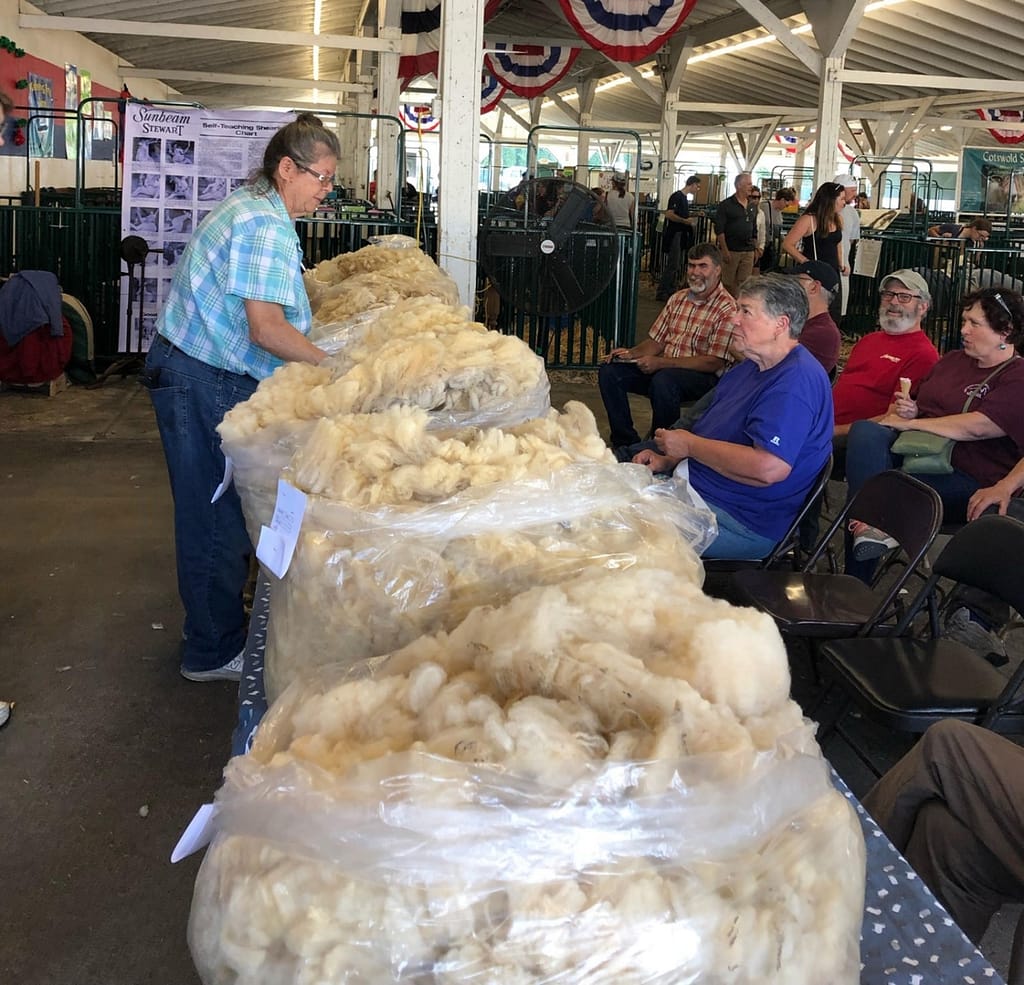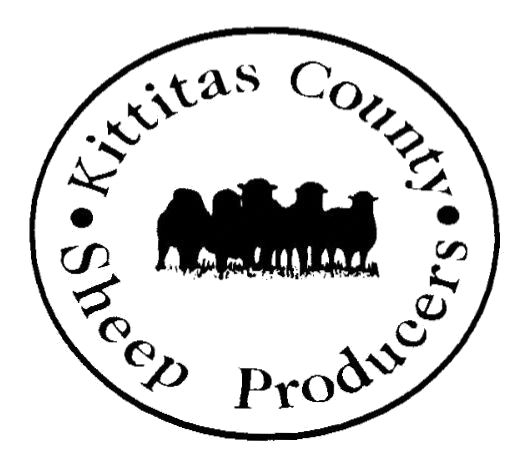- Where to buy sheep, lamb and wool products – list of county sheep producers
- Wool Show Fleece Preparation Helpful Hints
| Contact Information | Breed(s) of Sheep and Products |
| Starshire Ranch June Aploks Ellensburg, WA june@starshireranch.com www.StarshireRanch.com | Valais Blacknose Sheep Babydoll Southdown Sheep Breeding stock annually in Spring |
| Barnhart Ranch LLC 509-607-0180 barnhartranchllc@gmail.com | Cormo & Targhee fleeces for sale, great for crafts and spinning, by the ounce or fleece. Taking orders for half or whole locker lambs. |
| Cooke Creek Sheep Company Jami and Larry Beintema Ellensburg, WA 509-312-0169 lovelocalwool@gmail.com www.cookecreeksheep.com | Registered Texel and Coopworth sheep and crosses. Breeding stock Locker lambs Wool – raw and processed for all artistic uses – roving, batts, yarn, rug yarn, sheepskin rugs. |
| Jon and Julie Blackmore Ellensburg, WA 509-899-4204 jonblackmore1967@gmail.com | We raise Suffolk / Hamp cross sheep. Locker lambs |
| Rocky Roo-Bee Ranch Jim and Lisa Brewer 3560 Pheasant Ln Ellensburg, WA 98926 509-367-4883 | Award winning fine wools – Merino, Romeldale/CVM, Cormo and Alpaca. Breeding stock, fleeces, roving, yarn, finished items. |
| Emerald Farms Ellensburg, WA 509-968-9211 carrmarilynn@yahoo.com | Targhee locker lambs |
| 4G Farms Sharidyn Genge’ 509-607-6370 Find us on FB at 4GFarms, on Instagram at 4GFarms_wa or call us | We specialize in registered Bluefaced Leiceister sheep breeding stock. We feed quality alfalfa to our sheep which we grow and sell ourselves. Also, available for sale are raw fleeces, natural and dyed BFL locks and wool. |
| Parke Creek Farm Eric & Bambi Miller Ellensburg, WA 509-968-9630 parkecreekfarm@fairpoint.net | We raise fine wool sheep – (Targhee, Rambouillet, Columbia) in the beautiful Kittitas valley. We offer yarn, roving, fleeces and pasture raised lamb. Visit us on Facebook, Instagram or Etsy! |
| Justus Farm Ellensburg, WA Marti Parrish JustusAussie@earthlink.net 425.418.0269 | AGSS & GSBANA Registered Gotland Sheep Breeding stock, fiber animals, dog training sheep Registered Australian Shepherd Stockdogs |
Wool Show Fleece Preparation Helpful Hints

How do I prepare a wool fleece for show?
There’s nothing to lose but your small entry fee and lots of knowledge to be gained. Even if your fleece doesn’t win a ribbon you will be given the judge’s comments to help you on your way toward winning next time.
Once you’ve shorn that fleece which looks promising for show, check it for a wool break and check it in more than one place. Carefully remove a small lock, hold it at both ends and sharply yank the lock lengthwise. It should make a “ping” sound. If it crunches or tears, there’s a wool break and it’s disqualified for show. If the break is in the middle of a lock it might still be useable for hand spinning so don’t despair. If it’s partway down a lock it will no doubt be useable for felting. Once you’ve determined that your staple is sound and strong, you’re ready to proceed.
Lay the fleece out flat on a skirting table, piece of plywood, picnic table or wherever you will be comfortable working on it for awhile-shorn side up. Make sure the fleece is dry. You’re going to keep the fleece in one big sheep-shaped piece, and take out the stuff that’s no good for making beautiful yarn.
The next item on the list is skirting. Go around the outer edge of the fleece and remove all the lanolin tags, the belly, leg and neck wool. Take out the bottom-most portion of the britch wool. Some breeds are meant to have distinctive britch areas and you don’t need to remove all of that but get the ugly and unusable stuff off of there.
Remove all those second cuts. Second cuts are those short balls and hunks of fiber from when the shearer went over the same spot twice. Second cuts are big strike in judging as they detract from the ease of hand spinning as well as the end product. Shake the fleece without breaking it into pieces and many of the second cuts should fly up so you can locate them for removal.
Which brings us to the next item on the list-removing chaff and debris – vegetable matter (VM). Poop really isn’t welcome on the show table either, so go ahead and put that in your compost. Turn the fleece so the shorn side is down and then take out the hay and straw, and plan to spend plenty of time. If hay/alfalfa is in the neck area and is bad, just pull that neck bit off. Pull it off if it’s felted, too, you don’t want that judged. If it goes so far down the back that you’re changing the shape pulling off the bad fiber it’s probably not a good candidate for show. Often the tie breaker between two fleeces is the amount of vegetable matter left in one. The judge won’t unroll the fleece to count how many pieces of hay are left in; he can feel it by reaching into the bag and giving the fleece several strategic squishes.
Once you’ve worked on your fleece and feel pretty good about how clean it is, walk away for awhile. Have some lunch and answer e-mails or start fresh in the morning. When you go back to your fleece, close your eyes and put your hands on that wool and squeeze it. Do you feel the tell-tale prickles of hay and seed heads? If so, give it a little more love until it feels as good as it looks. When you’re done you can fold it for show.
Presentation counts and a properly rolled fleece is part of that, so you might need to do this more than once until it looks nice. You will start by having the shorn side down and take one long side (a front and a back leg once stuck out of this edge) and fold it halfway in. Then take the other long side and fold it halfway in, too, so the two long ends meet and make a “seam” down the centerline of the sheep’s back. Then you’re going to take the short end that the sheep’s tail used to stick out of and roll it toward the neck. You want this to be neat and compact, not loose and floppy and not hard and distorting to the fleece. Everything that is now showing is the shorn side of the fleece and it’s ready to bag. Don’t tie anything around the fleece.
You need a clear plastic bag that is neither so large for the fleece that it’s flopping around in there nor so small that the fleece can’t be moved around a little in there. For most fleeces a 32 gallon trash bag is about perfect but if you have a gigantic fleece that has to be stuffed into that, look for a 45 gallon instead. Clear bags are often sold in office supply chains and janitorial supply stores, sometimes in home improvement stores as well. Put your fleece in so that the neck edge is down inside and the seamless rolled surface is toward the opening.
All that’s left now is filling out your entry form, paying your fee and judging. When your fleece is received for judging it is assigned a number, a division and a class and the rest of your information is sealed until after the show. Nobody will know whose fleece is the one being critiqued except you if you should choose to come to the judging. And if you can come, please do! The judge will be making commentary to be included on the judging form. You will get your own judging form back to help you with your next entry but listening to the commentary on other fleeces can be invaluable, too.
Your fleece will be put into either the white or the naturally colored divisions, by fineness or wool character. See the entry form below for the details of the divisions and classes.
The judge will have all fleeces from the division currently being judged brought to the table and the bags will be opened so she can see them all. She will test for strength (wool break or tenderness) and all fleeces with a break will be removed from the judging table. Anything with lots of visible VM or other debris will be the next to be removed. When everything that isn’t going to qualify is gone, what is left will be assessed. Things that make a fleece jump out at a judge are “brightness” of color, (the way a color can pop and catch your eye) sheen and luster, crimp, staple length and the consistency of the staple overall and even weight. Fleeces are being judged on suitability for hand spinning and fleeces being an average or heavier than average weight for their breed is a plus, sometimes a tie breaker. Frequently the deciding factor between two lovely fleeces is which is cleaner so all your hard work really pays off in that deciding moment.
There will be people on hand to move and arrange fleeces and to record the judge’s comments for return to the producer. Ribbons are awarded for the best fleece in each class and a Champion (best in show) rosette is given to the nicest fleece of all. A Best Handspinning rosette will also be awarded.
If the fleece has also been consigned to sell, the comments and ribbons are sent on to you-the producer-and the buyer gets the fleece after the public has had some time to appreciate your fine work. Now that you know what’s going to happen it doesn’t seem so intimidating, right? It’s probably no more work than you’ll put into your favorite fleeces anyway or the ones that you know will bring you top dollar. It’s inexpensive to enter and you can get valuable feedback as well as seeing how your work stacks up compared to your peers. You also lend a little part of yourself to what is the very heart and soul of a fiber festival-the fleece! Entering your hard work in the show is another way to link fiber artists to the animals they adore and the farmers who make it all possible.
